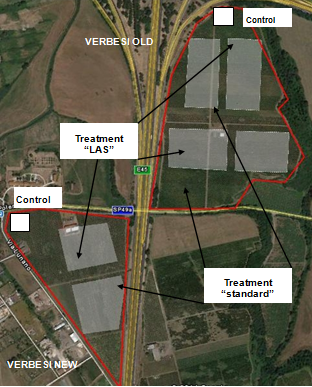Selected Pilot Area - Brief Experimental Design
Testing of pest monitoring and control using randomized complete blocks. The replicates (number of blocks, each block with a plot of each treatment) are 3; their size, depending on the available orchard surface, is around 3 ha (Fig. 9). Control (untreated) plots will be selected in the pilot orchard or in the wider area.
Two neighbouring orchards will be used for the Medfly scenario. Orchards are for more then 70% in full production, some new planted varieties will enter in production during the project execution. In the area, other peach and plum orchards are located and there is a history of high infestation. The orchards are multivarietal, but plots of the same block will have same cultivars. Their sensitivity to the pest damage has to be considered and different treatments will include cultivars with same sensitivity levels. Cultural conditions (e.g. soil type, fertilization, pruning, irrigation) are uniform in the entire orchard; records for each of them will be kept during the implementation.
Each plot will be of appropriate size to evaluate pest control and reach verified results. Limitations are the flight activity and movement of the pest. Indicative plot size for Medfly are about 3 ha for both LAS and traditional management treatments, while the control/untreated plot will have a small size (0.1 ha) and will be located in the experimental orchard or in the wider area. It is important to note that the distance between plots will be of minimum 50m. The plot border will have a buffer zone with a minimum distance of 20 m from the edge of the orchard, to prevent border effects.
Bellow is shown the Map of orchards and experimental design in Verbesi site.
